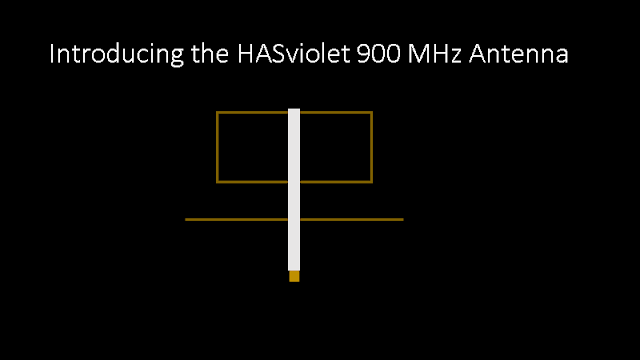This article will focus on the basic features and functions of the HASviolet antenna which is designed for the 900 MHz ISM and 33cm amateur radio band.
The HVDN HASviolet sets itself apart from all other projects involving LoRa as it seems the first to highlight the journey involved in bringing together hardware, antenna and software design and related best practices.
Lets now look at the HASviolet antenna!
HASviolet Antenna V1
This antenna is the original version that almost anyone can make using some easily sourced components. Our upcoming V2 version is further simplified, but instead of using a common pen as its body, instead will use a printed circuit board and be able to offer the user the ability to complete final assembly for use on both the 900 MHz shared ISM/amateur band plus the amateur radio only 1240 to 1300 MHz band.
More detail about V1 assembly can be found at hvdn.org/violet and the final version of the assembly and technical manual are known as V.05.
As you can tell by the above dimensions, our antenna is small. It easily can fit inside a folder or slipped into a notebook case.
We have decided to use the standard female SMA connector rather than any of the reverse polarity versions commonly found on some Wi-Fi devices and Baofeng or other Chinese low cost radios plus the newer and more expensive Alinco DJ-MD5TGP DMR radio.
The reason for this is to more easily sourced short jumper cables or barrel connectors to connect the antenna to the HASviolet hardware.
Also, the standard SMA is a better connector option since this promotes this antenna as a tool for licensed radio users that will use more than the power limited to unlicensed users of 900 MHz spectrum.
Following Instructions
Our step by step assembly manual is pretty detailed and should allow anyone to recreate this antenna with minimal fuss. There are some challenging issues however to consider if you wish to replicate this antenna:
Challenge #1 - COVID-19: Our original intent with this antenna was to sell them as pre-assembled kits or fully completed antennae in packages of two for around $20.00 USD.
These were going to be offered at the WOPR Summit which did not take place in March, but is now rescheduled for September.
Given the circumstances in the world today, we will instead hold these for later use and will focus on our V2 version which will be offered for sale in both kit and fully assembled versions in a few months or maybe sooner.
Making repeated trips to the post office now for such a small sale amount does not seem worth the health risk no matter what precautions are taken, even though we want to get as many of our HASviolet antenna's in use.
We may offer a mix of both versions for sale at WOPR Summit when it does happen and possibly even at HOPE 2020. It would be great to see you all there once the situation improves!
_____
Challenge #2 - Matching Section: One thing to be mindful of is that we stress that proper matching is critical for this antenna to function correctly.
We used RG-179 miniature coaxial cable which has a 75 ohm impedance compared to the more common RG-174 which has 50 ohm impedance.
This is clearly noted in our assembly and technical manual. In the kit form, we decided to already attach the SMA connector to the matching section to save you the cost of buying a dedicated crimping tool._____
Challenge #3 - Finding your own materials: HVDN has sourced a huge amount of phosphorous bronze rod from our local maker store, P&T Surplus to be used for product of both antenna versions.
Most people can purchase this easily online or from most hobby shops. A common pen should be the most easily found component and you probably already have one.
Beyond those two parts along with the already mentioned matching section, things like heat shrink, glue and scrap wire from an old Cat-5 cable should be easily found at most discount hardware stores.
Making the best of the situation
HVDN is a big fan of all things "open source" and we were looking forward to showing off our antenna at the also cancelled Open Source Hardware Summit prior to our official launch scheduled for WOPR.
What we have decided is to share our original design of the HASviolet V1 antenna and consider it an open source project so that others can improve upon it or ask us as many questions as possible.
All we ask is for credit to be shared back to us for the inspiration and to support us through the purchase of our even better V2 version once COVID-19 disappears.
Major Features of HASviolet Antennae
The really nice feature with our antenna is that it allows forward gain to increase the range of transmitted or received signals. It also offers the ability the reject signals behind it.
Having both a frontal "gain" lobe as well as a rear facing "null" lobe can be useful for radio direction finding, limiting interference of increasing range of signals otherwise not possible with a omni-directional antenna.
If orienting the antenna upwards, there is still some bi-directional capability thanks to the side lobes and there is also a near field omni directional capability too.
The benefits of this antenna are all in the actual placement of the antenna as well as to favor the polarity needed for certain tasks across wide bandwidth.
We have some videos on our official YouTube channel worth having a look at for more details.
There is also our technical manual for some additional details that are written for any audience to understand.
Thanks
Steve Bossert K2GOG
Founder, HVDN & HASviolet Antenna Person







No comments:
Post a Comment
We really do not want to moderate comments, so lets keep it easy to use until it becomes an issue.